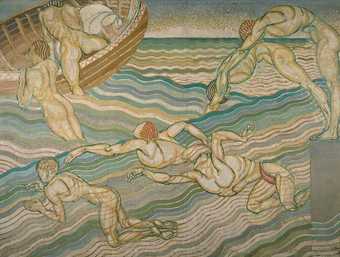
Fig.1
Duncan Grant
Abstract Kinetic Collage Painting with Sound 1914
Gouache and watercolour on paper on canvas
279 x 4502 mm
Tate
© The estate of Duncan Grant
Duncan Grant’s Abstract Kinetic Collage Painting with Sound 1914 (fig.1) is a genuinely radical work in British art history. Purely abstract, modernist paintings by British artists are rare in the early twentieth century; Grant, along with his partner Vanessa Bell, made a significant proportion of the few we have. That such an abstract work might move in front of the viewer, that it might be illuminated, that it might be accompanied by music, was extraordinary.
The work is often called ‘the Scroll’, rather than given the unwieldy title bestowed upon it in the 1970s, and the idea of this piece as a scroll – a strip of material that unwinds over space and time – is crucial to its conception. This informal nomination also alludes to the relationship between the work and Chinese handscroll painting, an art form dating back at least to the Song Dynasty (960–1279). That Grant and Bell were conscious of this affiliation with East Asian art is clear from the moment of the Scroll’s making, recorded in a letter from Vanessa Bell to the couple’s mentor and friend, the art critic Roger Fry: ‘Duncan and I do nothing here but paint. He has started on a long painting which is meant to be rolled up after the manner of those Chinese paintings and seen by degrees. It is purely abstract.’1 For young British artists such awareness was thanks principally to the work of the writer Laurence Binyon at the British Museum. Binyon had published the first survey of East Asian art in English, Painting in the Far East (1908), and followed it with The Flight of the Dragon (1911).2 The literary scholar Rebecca Beasley has observed that Binyon developed in these writings ‘a formalist vocabulary that effectively marks the difference between the compositional values of Chinese and Japanese art and the mimetic values dominating Western art since the Renaissance, while creating a means to understand it’.3
The traditions of Chinese art, however, were not the only source for this extraordinarily modern artwork. Grant had been experimenting with horizontal scrolls as early as the autumn of 1911, whilst on a tour of French Romanesque churches with Fry and his fellow critic Clive Bell, Vanessa Bell’s husband. The art historian Simon Watney has interpreted these works as precursors of the Abstract Kinetic Collage Painting, commenting that Grant explores ‘the abstract qualities of line and tone as much as the actual landscape before him’.4 What is notable here, in relation to his subsequent experiment with abstraction and kinesis in the Scroll, is that by 1911 Grant was already using the temporal development of space to undertake abstraction of forms from nature.
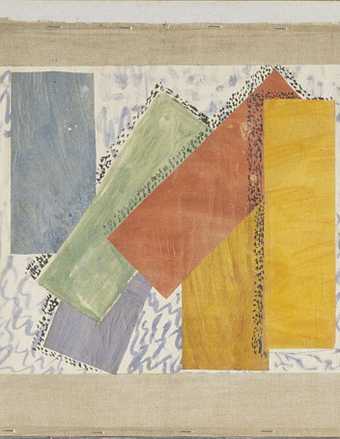
Fig.2
Duncan Grant
Abstract Kinetic Collage Painting with Sound, detail showing the seventh group of rectangles
© The estate of Duncan Grant
With the Abstract Kinetic Collage Painting Grant pushed this abstraction of form to its limits, supplementing it with Sound. With kineticism and the promise of movement, he added further novel and largely alien dimensions to modernist painting. The work in Tate’s collection consists of a raw canvas measuring 4502 mm long and 279 mm wide, onto which sheets of paper are glued, each covered with a field of blue and white calligraphic effects of varying density, so that they appear like marble. On these sheets, Grant at first glued, and then progressively painted directly onto the paper in gouache and watercolour, seventeen groups formed from six elongated rectangles, with one rectangle in each of the following colours: red, green, mauve, blue and two different shades of orange, and with most rectangles being hatched with ink along two edges (fig.2).
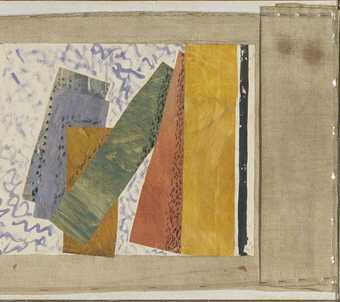
Fig.3
Duncan Grant
Abstract Kinetic Collage Painting with Sound, detail showing the first group of rectangles
© The estate of Duncan Grant
There is an ordering of colours within the clusters: the light orange rectangle is always on the top, always placed over the red, which is always followed by the green, and then – although the rotation and dispersal of the lower rectangles in some groups does not always make it easy to register this – by the dark orange, the mauve and the blue. If we read the canvas horizontally, from right to left – as the description in the Tate Report of 1975 does – each rectangle is orientated differently within almost every set. We begin with a painted, vertical black line, and then a vertical orange rectangle from beneath which the other colours rotate and are displaced (fig.3). There follow serial movements of rectangles within each set that do not appear to follow any particular rule, though by the time we reach the thirteenth and fourteenth sets almost all the rectangles are horizontal, or near to it, having started out vertical or near to it. They are succeeded, however, by three sets in which all the rectangles are vertical and ultimately appear stacked upon each other, so that in the seventeenth set only the light orange form is properly visible. Nor are the sets discrete: only the first, seventh and eleventh sets are not in contact with another set; most sets are in contact with those on either side. At some points this is merely a matter of tangential contact; in others the relationship is more complex, with rectangles from one set intercalated with those of another, to the point where one set might be read as a subset of another.
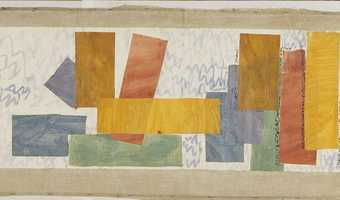
Fig.4
Duncan Grant
Abstract Kinetic Collage Painting with Sound, detail showing the light orange rectangle connecting the tenth and ninth group of rectangles
© The estate of Duncan Grant
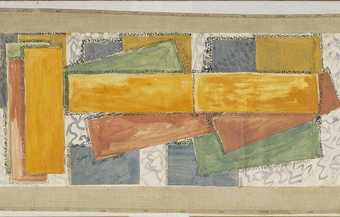
Fig.5
Duncan Grant
Abstract Kinetic Collage Painting with Sound, detail showing, left to right, the fifteenth, fourteenth and thirteenth groups of rectangles
© The estate of Duncan Grant
The light orange rectangle is the most active form in creating these relationships, establishing an almost continuous flow between the groups (fig.4). The colours beneath this orange rectangle are used to further complicate the relationships: the red in the fourteenth set not only overlays the green and the mauve of the thirteenth, but is itself overlaid by the red and the light orange of that set, and the light orange rectangle of the fourteenth set is overlaid by its counterpart in the preceding group (fig.5). The contradiction here between temporal and spatial sequence might actually lead us to question if the Scroll was intended to be read right to left, as the Tate catalogue does. Furthermore, the green rectangle of the fourteenth set, at a declination of some ten degrees from the horizontal, intrudes into the wholly vertical stack of rectangles in the fifteenth.
If our attention to form here seems over-fastidious, we suggest that it is crucial. Given the debates that surround the Scroll in terms predicated upon the continuous flow of images in time, and given the nomination elsewhere of the work as ‘proto-cinematic’, the organisation of the Scroll is vital evidence to which we shall return in our individual essays. For the flow of these images is not established by the Scroll’s movement, combining a series of static moments into the illusion of continuous movement – as a film would – but is inherent to its entire surface.5 Although Grant later said that he intended the work to be ‘driven’, we know that it was moved first of all by human hand: being progressively unwound as a handscroll would have been. This was how the artist and his friend David Garnett showed the Scroll to a group including the novelists D.H. Lawrence and E.M. Forster in Grant’s London studio early in 1915.6 When rediscovered, the work – like Chinese handscrolls – had wooden batons at either end which were clearly used in the winding process, and these are preserved separately at Tate.
To the already radical concept of movement, Grant added a further innovation: paper glued to the canvas – something that he had recently encountered on a visit to Pablo Picasso’s studio in Paris.7 While he was in the city, Grant also clearly found time to inspect Picasso’s works at the gallery of Daniel-Henry Kahnweiler.8 Collage in the work of modernist artists like Picasso and his fellow cubists Georges Braque and Juan Gris was commonly used to invoke the concrete reality of objects, before representation, while at the same time sliding into the simultaneous symbolising of other, imagined objects. As the art historian Christine Poggi has put it, ‘wallpaper may represent wallpaper … but it will also be converted into a means of signifying the virtual body of a violin’.9 Both Braque and Picasso were fond of using a wallpaper printed with an imitation wood grain, known as faux bois. Grant, on his visit, had taken to Picasso a precious roll of nineteenth century papers that he found in the boarding house where he was lodging. Humble, domestic wallpaper was important to Grant’s Scroll. This was not simply because he knew that leading cubists were working with it in their painting, beginning with Picasso’s Still Life with Chair Caning 1912 (Musée Picasso, Paris). Rather, the roll of wallpaper accorded with, and perhaps even initiated, a concept of the flow of visual forms in a domestic setting.
However, as Alexandra Bickley Trott shows in her contribution to this project, the thus-far neglected aspect of Grant’s use of collage in the Scroll needs to be addressed. Collage was enormously important to cubism’s critique of representation: elements of real things were used by artists to interrogate the relationship between the object in the world (the absent thing conventionally signified by representational painting) and its representation (the sign, or signifier) by including an element of the real object (the referent). That cubist artists thought of their work in terms of language has been widely claimed by art historians. T.J. Clark has remarked: ‘Cubism as its first makers and users saw it was, or appeared to be, more than a pictorial syntax. It was a semantics.’10 Examining Picasso’s elimination of depth and modelling in the pictorial field – a process completed through collage – Rosalind Krauss makes a claim for ‘a change not within the system of illusion from one type to another, but a conversion from one whole representational system, roughly called iconic, to another roughly called symbolic’.11 Yve-Alain Bois proposes that this shift from painted, analytic cubism to the papiers collées of collage is to be understood in fundamentally linguistic terms.12 Yet in Grant’s canvas, the collage elements have no apparent referent in the world: they are pure abstract forms, cut, painted paper rectangles. Still, they have something in common with cubism’s formal use of collage: they almost eliminate depth of field. Indeed, Grant subtly reintroduces it by modelling the edges of the rectangles with ink hatching. Furthermore, while they are rendered in different media, there are no formal differences between the collaged, painted and glued shapes and those rendered directly onto the paper.
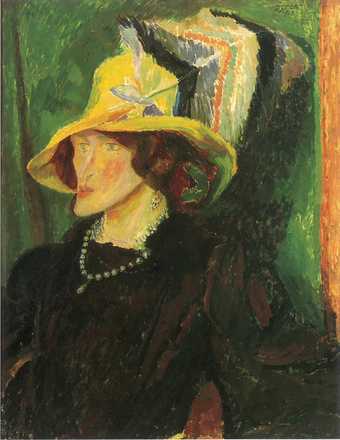
Fig.6
Duncan Grant
Portrait of Lady Ottoline Morrell 1913
Oil on panel
830 x 640 cm
Private collection
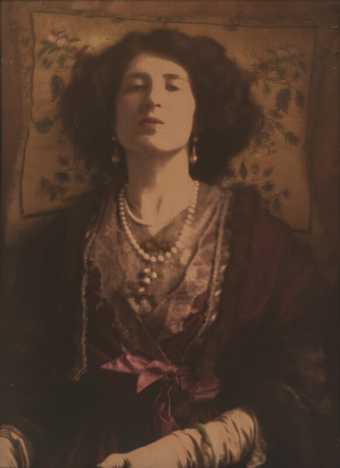
Fig.7
Baron Adolph de Meyer
Lady Ottoline Morrell c.1907
Half-plate autochrome
National Portrait Gallery, London
Grant was aware of the purpose of modernist collage: he had begun to experiment before he met Picasso, including a string of artificial pearls in a 1913 portrait of Lady Ottoline Morrell (fig.6).13 This was probably inspired by the futurist artist Gino Severini, who included sequins on his painting Blue Dancer 1912 (Solomon R. Guggenheim Museum, New York), in his exhibition at the Marlborough Gallery in April 1913. As Bickley Trott suggests, the pearls in the Morrell portrait imply a deeper consciousness of the play between reality and representation. A c.1907 autochrome of Lady Morrell (fig.7) by the photographer Baron Adolph de Meyer makes her double string of pearls its focal point.14 For its imagery, photography depended upon the material presence of its objects in a way that painting did not. If a painted necklace was not, really, a necklace but a representation that did not depend upon a singular referent, a photographed one was dependent on the materiality of its subject, and the colour process of the autochrome further emphasised that truth. Grant thus used a genuine necklace (if not genuine pearls) to demonstrate the entry of reality into pictorial representation. But if that was the case in a portrait of a person, what was Grant doing in first establishing and then eliding the difference between collage and paint in non-objective, abstract painting? After all, an abstract rectangle surely has no referent in the real world?
Bickley Trott suggests Grant wanted to demonstrate that, for all its invocation of a reality outside the artwork, collage remained representational: after all, as Poggi acknowledged, one of the virtues of collage is its ability to be both object and sign. As Bickley Trott observes, following the arguments of art historian Judith Collins, Grant’s distinctive use of collage is fundamentally materialist: it allows him ‘to bring about a more concrete contact with reality’.15 To Picasso’s collage, Grant poses the retort that the ‘reality’ self-consciously introduced to cubist painting was itself also already a displaced sign. Therefore, what cubism’s use of collage pointed to was not the object as object but the history of its representation.
Since the only difference between the rectangles in the Scroll is one of medium, it is impossible without close observation to tell which is the collage and which the painted representation. However, Grant’s elision of difference also gestures towards abstraction from nature. As Bickley Trott shows, the abstract rectangles have a distant referent in the material, human bodies found in some of Grant’s earlier paintings. Bickley Trott suggests that what Picasso and Grant ultimately have in common, despite very different conceptual premises for their work, is a shared interest in materialism. The rhythmic grouping of the six rectangles in each set of the Scroll, especially when their movement is accompanied with music, helps us see these shapes as bodies. Grant was fascinated by the rhythms of bodily movement, having been inspired by a visit to the studio of Henri Matisse in 1911 and seen the French artist’s The Dance 1909–10 (State Hermitage Museum, St Petersburg). Grant made a version of this work in his own Dancers 1911 (fig.8) and also used repetition and displacement of the human form in his study of swimmers in the Serpentine, Bathing 1911 (fig.9).
Grant’s use of abstraction here, and the insistence on materialism, hints at the philosophical debates around abstraction, knowledge and the representation of objects that permeated the Bloomsbury Group of writers and artists before the First World War. In his first essay of this project, Christopher Townsend looks at how Grant, along with Vanessa Bell, was exposed to those ideas and then translated abstract rhythms in designs for a domestic setting into parallel bodily movements. He also shows how the Scroll, in an idealised, completed form, might fit into such a programme of rhythmic kinesis that includes both furnishings and garments.
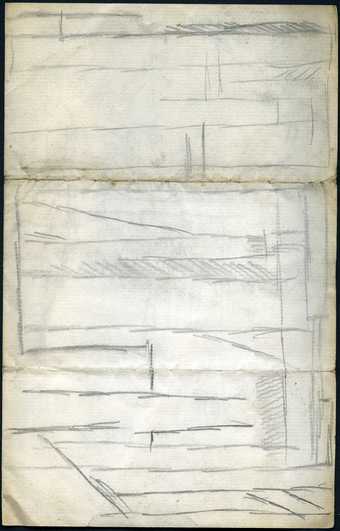
Fig.10a
Duncan Grant
Sketch on the verso of the letter sent to Grant by the London Joint Stock Bank Limited
Henrietta Garnett Bequest, Tate Archive TGA 20078/6

Fig.10b
Letter to Duncan Grant from the London Joint Stock Bank Limited, 26 January 1914
Henrietta Garnett Bequest, Tate Archive TGA 20078/6
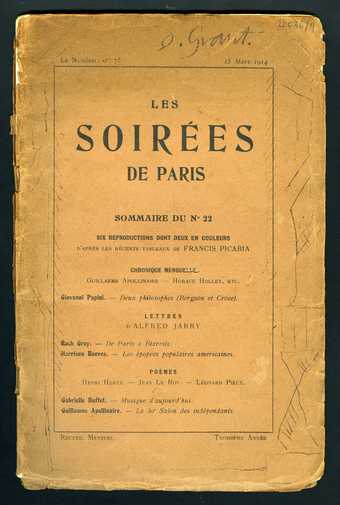
Fig.11
Duncan Grant
Sketch on the cover of the March 1914 issue of Les Soirées de Paris
Simon Watney Papers, Tate Archive TGA 20036/4
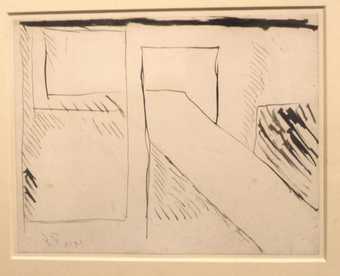
Fig.12
Duncan Grant
35 mm colour transparency of an ink on paper drawing related to the Scroll, undated [c.1914]
Simon Watney Papers, Tate Archive, TGA 20036/12
The Scroll was begun just as western Europe and its empires were going to war, though Grant had made preliminary sketches a few months earlier, in Paris. The first of these (figs.10a and 10b) – exploring colour sequences in abstract forms – gives an approximate earliest date for the Scroll’s conception; it is on the verso of a letter from his bank, addressed to Grant in Paris, dated 26 January 1914. The second sketch (fig.11), related to the pattern on the Scroll but actually a design for a carpet, was made on the cover of the March issue of the Parisian art magazine Les Soirées de Paris. The claim for the relationship of this drawing to the Scroll goes back to Simon Watney in 1980.16 A further sketch dated 1914 shows some evolution from this towards the patterning of the Scroll (fig.12).17 Grant seems to have abandoned work on the Scroll in 1915 and the idea of abandonment at this point is important to the three scholars working on this In Focus project – for whilst the surviving canvas is undoubtedly significant in the history of modernist painting, we do not believe that Grant was able to complete the project. We observe that there are fundamental differences between the material object that survives in the Tate collection and the various written accounts of and sketches for the project from 1914–15. Furthermore, there are inconsistencies between the object and Grant’s much later recollections about its making. The work was left incomplete, we suggest, for three reasons: first, Grant’s circumstances changed – his sincere pacifism during the First World War meant that he was compelled to work long hours as a farm labourer and had little time to paint; second, both he and Bell moved away from abstraction after 1915–16; and finally, the technology necessary to complete the work was not available to him. The Scroll is in some senses a work to be realised in imaginary media, so definitively unfinished, or one which needed reconfiguration to run on the available technologies.
Some hint as to ‘what might have been’ can be found in a letter from the novelist D.H. Lawrence, written to Lady Morrell immediately after seeing the work in January 1915. Lawrence is sceptical about the project, associating it with developments in European modernism with which he was familiar. (Lawrence had read futurist literature and manifestos not only in translation but also in the original French and Italian.)18 He wrote: ‘Tell him [Grant] not to make silly experiments in the futuristic line, with bits of colour on moving paper’.19 There is a telling discrepancy between Lawrence’s account of the visit to Grant’s studio, which he made with his wife Frieda and E.M. Forster, and the account by David Garnett. This difference perhaps opens a window onto Grant’s ideas for the development of the Scroll. Garnett describes a band of cotton [canvas] on rollers – what sounds like the Scroll as it survives in the Tate collection;20 Lawrence writes of ‘experiments’ – work that is provisional, not completed – and of ‘moving paper’ that bears ‘bits of colour’. This was not casual writing on Lawrence’s part: he was a painter himself, and would acknowledge immediately the difference between canvas and paper. He was also a very precise writer, likely to use the correct nomenclature. We suggest that where Garnett is describing what already existed, Lawrence is referring to a suggestion by Grant to the possible future development of this ‘experiment’. Where Lawrence was perhaps mistaken is in associating Grant’s kinetic abstraction directly with futurism and that movement’s enthusiasm for speed and pure form. As Townsend shows, however, we should not ignore the influence of futurism on Grant, both directly and indirectly, through other streams of European modernism.21 What Grant had so far pursued within his approach to abstraction was the extraction of forms from nature – what Lawrence imagined to be the only meaningful use of abstraction.22 Lawrence’s retort to what seems to be a still-nascent concept of movement rather than a fully realised material form has informed our practical project to test how that conception might have been achieved within the technologies of 1914.
The Scroll remained in Grant’s studio in Fitzroy Square, London, until 1939 when it was moved with the rest of the studio’s contents to Charleston, the Sussex farmhouse Grant and Bell shared from 1916 to 1961, in order to protect it from bombing raids. It was there, in 1969, that Simon Watney – then an undergraduate at the University of Sussex and working as Grant’s assistant – rediscovered it in a loft. Watney unwound the heavy canvas on the lawn at Charleston and in amazement asked what it was. ‘Something that I made before the war’ was Grant’s reply, meaning not the Second World War but the First.23 Recognising the unique object that lay before him, Watney hurried to telephone Richard Shone, at that time almost the only art historian with a serious interest in the visual arts of the Bloomsbury Group. The Tate Gallery moved quickly to acquire the work in 1973, and curator David Brown – a specialist in British abstract painting – interviewed Grant, who was by then in his late eighties.24 However, a number of statements were made in that interview which, treated as unproblematic facts, have profoundly affected subsequent interpretations of what the Scroll was meant to do and how it was meant to do it. Those problems arise from Grant, at sixty years’ remove, reflecting on intentions and aspirations he had had for the work, and from Brown over-estimating the capacities and types of the technologies available to the artist in 1914.
As Rhys Davies shows in this project, Tate’s failure to conceptualise the project in 1974 within a framework that was simultaneously imaginative and historically feasible led to impossible claims about the work.25 These failures were, eventually, not restricted to Brown – who neglected to challenge statements by Grant, particularly his remark that the Scroll was to be moved ‘by mechanical means’. This failure led to the eventual reconstruction of the work by the Tate Gallery using technologies and media concepts which were neither available to Grant in 1914, nor in accord with the discourses in which he participated at the time. Brown assumed that the media technologies of the 1970s were equally available to an artist in 1914, as a conceptual horizon if not as material form, when the reality was very different. The Tate Gallery reinforced the notion of the work’s ‘cinematicity’ by making a film of it, which is now in the gallery archives.26 Given the limited exhibition of the fragile physical object, this meant that the most available medium through which the work might be understood was a large image projected in a theatre or lecture room, moving at a steady rate and accompanied by a synchronised sound track – a stately rendition of the Adagio from J.S. Bach’s first Brandenberg Concerto, BWV1046.
The film misrepresents the Scroll in terms of scale and materiality. It becomes a large, disembodied moving pattern of light on a wall; far larger than the field thrown by most projectors of 1914, and something that might be viewed in a proscenium arch theatre – a mode of exhibition profoundly at odds with the project’s origins in Chinese handscrolls. Brown initially agreed with Grant that the thrown image should be only eleven by twenty-four inches (279 x 610 mm), matching the size of the viewing window specified by the artist in 1972. In reality this would be almost impossible to achieve with a conventional film projector without obstructing the view of any spectator, because it would have to be between them and the screen. On the occasions that Tate has screened the film it has been shown with a conventional, large throw of the image from a projector behind the audience.27 If it did nothing else, screening the film with the dimensions proposed by Grant would demonstrate the vast practical and conceptual differences between his understanding of the work – and its limited realisation as material form – and the Tate Gallery’s attempt in the 1970s to render it as cinema.
Davies’s critical appraisal of the work’s technologies shows how the Tate Gallery misunderstood and misrepresented Grant’s project. The Tate film is a prime example of how prevailing scholarly fashions in art history and film studies in the 1970s contributed to misconceptions of a kinetic work realised in 1914. The Scroll’s kinetic property resided in the continuous movement of the fabric, not the synthesis of intermittently moving images through persistence of vision. But at the time, modernism was understood to be characterised by medium-specific formalism – abstract canvas-based painting was its apogee, and the formalist critical imperative extended in the 1970s to film. In this era, the possibility of complex, hybrid media works with functions beyond the purely aesthetic (being situated for example in a domestic setting) was not so much disparaged as ignored. The sheer diversity, and utopian strangeness, of technological experiment in modernist art was thus reduced retrospectively to categories which either did not exist at the time for the artist, or which that experiment sought to transcend.
It was a mistake in the 1970s to think of the Scroll as ‘proto-cinematic’, since when it was made film as medium had already existed for twenty years; it remains a mistake now. The Scroll was not an attempt to anticipate or even be film. Grant was trying to do something different, with different materials. The Scroll does not emerge from even the wildest discourses that surrounded cinema in 1914. Rather, it comes from the expanded field of modernist painting and fine art. The treatment of the work as filmic depends upon something like the Whig view of history – the notion of inexorable, natural, technological progress in human culture – fitting what were experimental, aberrant or imaginary forms of media into fully realised contemporary modes, and ignoring the actual historical circumstances of their making, or their imagination, in the process. If we might reasonably expect a mid-twentieth-century curator such as Brown to follow such a path in order to reconcile the conflicting concepts and media he was presented with, it is a little more surprising to see such a path beaten by our contemporaries. Tate’s analysis of the work is typical of mid-century appraisals of modernist art that not only employed several different media in their composition, as well as technologies alien to fine art traditions, but which sought to bridge or at least analyse the conceptual differences between those media. Such projects, whether essayed through synaesthesia (the idea that painting and music might have similar effects on the spectator) or intermediality (the idea that the rhetorical forms of one medium might be transposed into another), were often attempts to evade the confines of category altogether, rather than failures to escape a traditional medium for one that was ‘modern’.28 Brown’s project realised the Scroll not in the terms of its imaginative conception but as if it were an inadequate, failed attempt at what had since been realised in perfect form in the cinema of his own time.
The Tate Gallery’s treatment of the Scroll in the 1970s often leads contemporary scholars to interpret it as both immaterial and made for projection in a public space.29 But there is no evidence that the work was ever intended for projection. Indeed, it would have been impossible to project light through the paint and paper-covered canvas, even supposing an apparatus could have been found that could carry the size and weight of that canvas without destroying it. If the original work were to be illuminated, it would have to be front lit, and given the limited luminescence of light bulbs in 1914, even then it could only be seen properly close up. Grant certainly intended the Scroll itself to move, and to be illuminated. However, the intended scale of that viewing window necessarily limited the number of spectators to a handful and stressed the materiality of their relationship to its movement. This is a material thing that moves, not a stream of light. The Tate Gallery’s film erased any notion of the haptic and the intimate from the work, yet handscrolls are profoundly intimate and haptic, and the viewing window originally postulated by Grant would not be suitable for anything but intimate viewing.
As for the sound, as Davies shows, even if any of the Brandenberg Concertos had been committed to record in 1914, which they had not, the Adagio of the first played according to the performance standards of the early to mid-twentieth century would not have fitted the available capacity of a disc or cylinder of the time.30 In a move typical of his retrospective imposition of technologies, Brown determined the duration of the work using a piece that had not been recorded at all in 1914, and which accompanied it through a technology – an electronically amplified, synchronised soundtrack – that also had not been available. Indeed, the choice betrays still more about Brown’s confused thinking about the Scroll. There is no fixed length for the Adagio of the concerto, BWV1046 – so really an unwinding of the Scroll does not have one either, if we assume this to be the appropriate accompaniment. But, of course, a film can only run at a fixed speed, like a mechanical recording of a specific musical performance. One of the earliest recordings of BWV1046, which would be close to the performance practice of Grant’s own time, is that of the Berlin Philharmonic under Alois Melichar in 1933. Melichar’s recording took four minutes and fifty seconds for the Adagio; yet Christopher Hogwood with the Academy of Ancient Music in 1985, reconstructing Bach’s music to period pitch and pace, got through it in a breakneck three minutes and thirty-seven seconds. Reinhard Goebel with Musica Antiqua Köln would in 1987 set a new world record for the Adagio in three minutes and eleven seconds. So it is only with the extremes reached by the ‘early music’ movement of the 1980s and performance practices anathematic to those of the 1910s that we find a recording of the chosen piece that might actually fit on a 1914 technology of sound reproduction. If we are to say that the Adagio from BWV1046 is the appropriate accompaniment, we have a potential duration for the Scroll that varies by nearly two minutes.
So why did Brown decide that Grant had, in 1914, anticipated that Jörg Farber and the Württemberg Chamber Orchestra would come up with the optimal duration for the work when recording the concertos in 1966? Clearly, in making a film for public exhibition and associating it with commercially recorded music, the Tate Gallery would have to pay for the rights to that music: could it have been that those pertaining to Farber’s recording for Turnabout were significantly cheaper than those available from more prestigious orchestras and record labels? There were, by 1974, at least twelve commercially available recordings of the Brandenbergs to choose from, with Adagios from BWV1046 of differing lengths: so why Farber’s? Indeed, why Bach, and why a Brandenberg Concerto? Perhaps because supplementing early experimental film with Bach was a cliché of their recovery in the 1970s and 1980s: the rhythms of the Baroque seemed strangely suited to the material. In his personal teaching collection for avant-garde film Christopher Townsend has early commercial NTSC video copies from the 1980s of Francis Picabia and René Clair’s Entr’acte 1924 and Fernand Léger’s Ballet Mécanique 1924. Both were fitted to recordings of Brandenburg Concertos in the absence of their original scores composed in the 1920s. We would see Tate’s use of the low-profile Farber recording as obeying the same impulse at a sensible price.
A crucial element of our project was, therefore, the scraping away of these accumulated ideas and ahistorical assumptions about the Scroll to return to what was technologically and historically possible for Grant in 1914. From there we were able to understand how Grant might have begun to reshape the ‘experiment’ into a form in which his ambitions could be achieved. What we were attempting was not a work of conventional media archaeology – after all there was no completed technology to work with but only a canvas, statements, drawings and descriptions of events. Rather, our interest in the possibilities of what might have been led us towards the projects outlined by some of the contributors to the 2011 collection Media Archaeology, edited by media archaeologists and theorists Erkki Huhtamo and Jussi Parikka.31 We wondered in particular how the ideas of media theorist Eric Kluitenberg might be applicable to our research.32 If the Scroll was never meant to be cinematic, could it have worked as a mechanised, kinetic device, illuminated, clearly encased (how else to cut a viewing window?) and accompanied by music from a separate source?
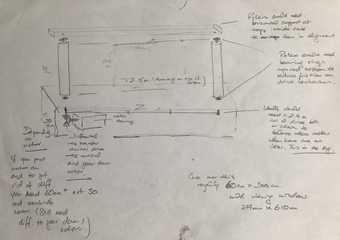
Fig.13
Christopher Townsend
Working sketch for the horizontal operation of Duncan Grant’s Abstract Kinetic Collage Painting with Sound, 2015
© Christopher Townsend
A key part of our endeavour is to show that the work, as it survives at Tate, could never have been made into the kind of illuminated, kinetic work of art that Grant said it could. It would certainly not have been possible using 1914 technologies and, indeed, it would not be possible now. The mass of the canvas as Grant left it would require an industrial-scale motor to drive it: not a small-scale electric motor, for there were no alternating current motors in 1914; not clockwork, for the drive mechanism in a domestic unit would have soon broken under the strain of trying to move the load. As Davies shows, the only available electric motors would have been single phase induction devices that operated at around 600 rpm, which, presuming they could actually move its mass, would have driven the Scroll far too quickly (even for Goebel and Musica Antiqua Köln’s recording of the Adagio). To propel the Scroll horizontally would have required an apparatus that looked something like the sketch in fig.13. The two poles would each have needed a ring of bearings at top and bottom to reduce friction in their rotation – that is, they would have to have been a sophisticated piece of machine engineering, in metal. To transmit the drive from the motor would also have required a complex differential beneath one of the poles, to change the drive from horizontal to vertical. Failing that the motor would need to be mounted vertically beneath a pole. This would have deleterious effects for the life of any industrial motor designed to normally operate horizontally because of problems with balance and lubrication. Equally problematic would be the consequences of mechanically driving the work over rollers. We are dealing with canvas, with painted paper glued to it and collage glued to the paper: the paint would soon flake and sooner, the paper would become detached from its substrate. To have mechanically driven the Scroll as Grant left it in 1915 would have been an early work of auto-destructive art. Furthermore, as Davies points out in his essay, the noise of an industrial scale ‘synchronous motor’ would have made it impossible to hear the accompanying sounds from the gramophone, since there was no electronic amplification of the recording, only a horn that required listening to be up close and personal.
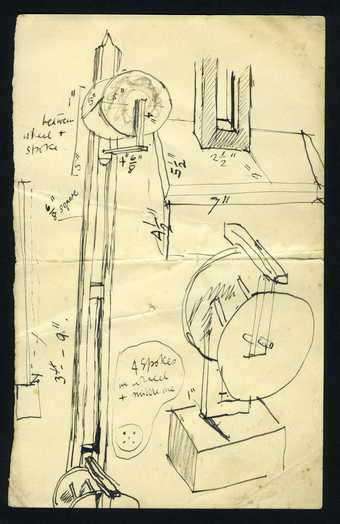
Fig.14
Duncan Grant
Sketch for a winding mechanism for the vertical operation of a version of Abstract Kinetic Collage Painting with Sound c.1913–14
Simon Watney Papers, Tate Archive TGA 20036/3
We contend that however significant it is in itself – and that is significant indeed in the histories of European modernism – what survives at Tate is an abandoned prototype for an imaginary, utopian experiment that, had it been completed, could have been run using period technology. Davies shows that the work was effectively transformed by Tate in ways that ignored the historical and technical conditions by which it was framed. We set out to try and complete it by re-historicising those parameters. Our argument was supported by the drawings Grant made for a winding mechanism (fig.14): this could not have carried the Scroll that we have today but could have borne an iteration that was much smaller and lighter. It might also have been adaptable to an available and suitable clockwork motor. There is no other work by Grant to which this design might be applicable, and Simon Watney, in his authoritative monograph on the artist, makes a clear association between it and the surviving canvas, even if he states that the dimensions of the device in Grant’s sketch exactly match those of the surviving Scroll, when they patently do not.33 To fit the device, the strip of material carrying the abstract patterns would have to be only 75 mm wide, a quarter of the width of the canvas in the Tate, with a corresponding reduction in length. The dimensions of the plinth on which the armature is mounted are such that only a small clockwork motor could have been accommodated within it, and even then the arrangement of a drive mechanism would cause problems of fit, and as we found, resonance within the case. Any motor would still need relatively complex gearing to regulate the speed of movement of the lightweight, smaller Scroll. Furthermore, this mechanism would have moved the strip vertically, rather than horizontally (as Chinese handscrolls unroll) as seems to have been both Grant’s original intention and his memory of the work in 1972. But such a transposition of orientation and scale would allow for the printing of the abstract devices on light, thin fabric easily moved by a weak motor and illuminable from behind by a 1914 lightbulb in a way that thicker canvas and paper were not. We had an historical precedent for this solution. In 1912–13 the American post-impressionist Van Dearing Perrine (1869–1955) had gone so far as sketching a device where rolls of coloured tissue paper moved past a back-lit aperture. Grant is unlikely to have known this work, which was not mentioned in a publication until the 1920s, as Perrine did not leave the US.34 Furthermore, it would now be possible to place a period gramophone alongside the device, and – if the resonance problem from the motor inside the case could be addressed – for it to be audible. In making the sketch, we believe that Grant was experimenting with a technical compromise that made some form of movement and hearing possible for some form of patterned material that might scroll past the viewer.
Our hypothetical construction, derived from Grant’s ideas and the period comments of others, followed a process that might be termed ‘hands-on history’ (with a respectful nod to our colleagues working on TV technologies and practices from the 1960s and 1970s).35 Using the sketches Grant left as our guide and employing only the technologies available to him in 1914, such as clockwork motors, lightbulbs of the correct luminesence and wind-up gramophones, the construction sought to realise what a completed version of the Scroll might have looked and sounded like. As our film of the hypothesised device shows, this created something very different from the surviving object.36 Given the scale of the winding mechanism, the means of its musical accompaniment and the weakness of its illumination, and acknowledging the arguments made in Townsend’s essay for the close relationship between the patterning of the forms on the Scroll and Grant and Bell’s designs for carpets, rugs and fabrics sold by the Omega Workshops, we filmed the device in a setting that approximates to a Bloomsbury drawing room of the period. If Grant’s Scroll in this form would have anticipated any technology, it is not film but television – a very different medium not only in its technologies but in the modes and sites of its consumption. In doing this we happily acknowledge gaps in conception: there could be other ways of making the Scroll move, just not in the form in which Grant left it; there may be inadvertent errors in the mise-en-scène – the wonderfully imaginative set designers in the Department of Media Arts at Royal Holloway did not have the budget to achieve greater verisimilitude. We financed most of the design and construction of the apparatus ourselves, working with film industry professionals from Cogprops, and could not afford a modern replica rug to Grant and Bell’s design, nor borrow for the shoot a genuine Bloomsbury Group painting, nor pay a professional actor. The gramophone is a good replica, and the disc it plays is from 1914.
Our final essay, the second by Christopher Townsend, looks not at the influences on the Scroll but at the work’s possible after-effects, its influences upon other artists and writers in the Bloomsbury Group. Townsend attends in particular to the abstraction from nature within a kinetic model – Watney’s interpretation of Grant’s practice in making the Scroll – achieved by Virginia Woolf in the opening of ‘Kew Gardens’, her important short story of 1917. The style that Woolf developed, of which the first fruits were the stories written and published between 1916 and 1919, is often claimed by literary critics to have been profoundly influenced by either the cinema, or by modernist painting. Townsend’s essay challenges the supposed ‘cinematicity’ of Woolf’s writing at this point and the influence of modernist painting, particularly cubism, on her work. The cinematic techniques most often referred to in analysis of these stories and subsequent novels – including Mrs Dalloway, Jacob’s Room and To the Lighthouse – did not appear in cinemas until the mid- to late 1920s. Woolf had little access to post-impressionist painting, other than that of her sister and fellow members of the Bloomsbury Group, after 1911. And much of this was work for which she expressed an affected distaste. It was not until Picasso’s show at the Leicester Galleries in 1921 that Woolf would have had any opportunity to see a significant body of his cubist work. Townsend suggests that a more viable model of influence for the abstraction of nature into pure colour and geometric forms is Grant and Bell’s work, especially their abstract painting of 1913–15. Furthermore, the Scroll as then introducing the kinetic to that abstraction provides Woolf with an accessible model for the movement of those abstracted forms that characterises ‘Kew Gardens’. Townsend’s second essay thus continues our project of re-historicising the Scroll, placing it into the wider context of Bloomsbury’s artistic endeavours and contributing to our overall reappraisal of the work’s importance in one of the most important movements in British modernism.


